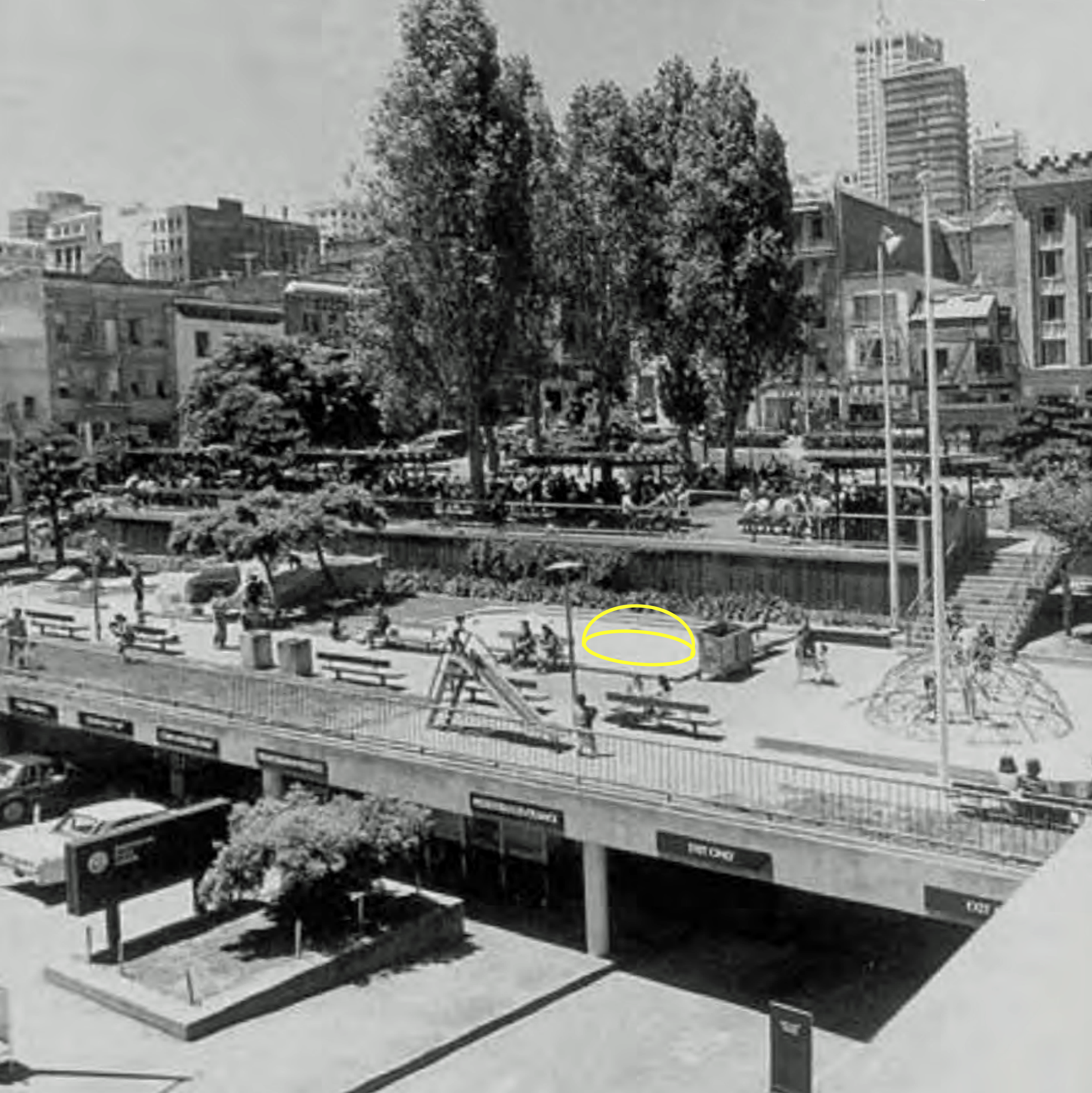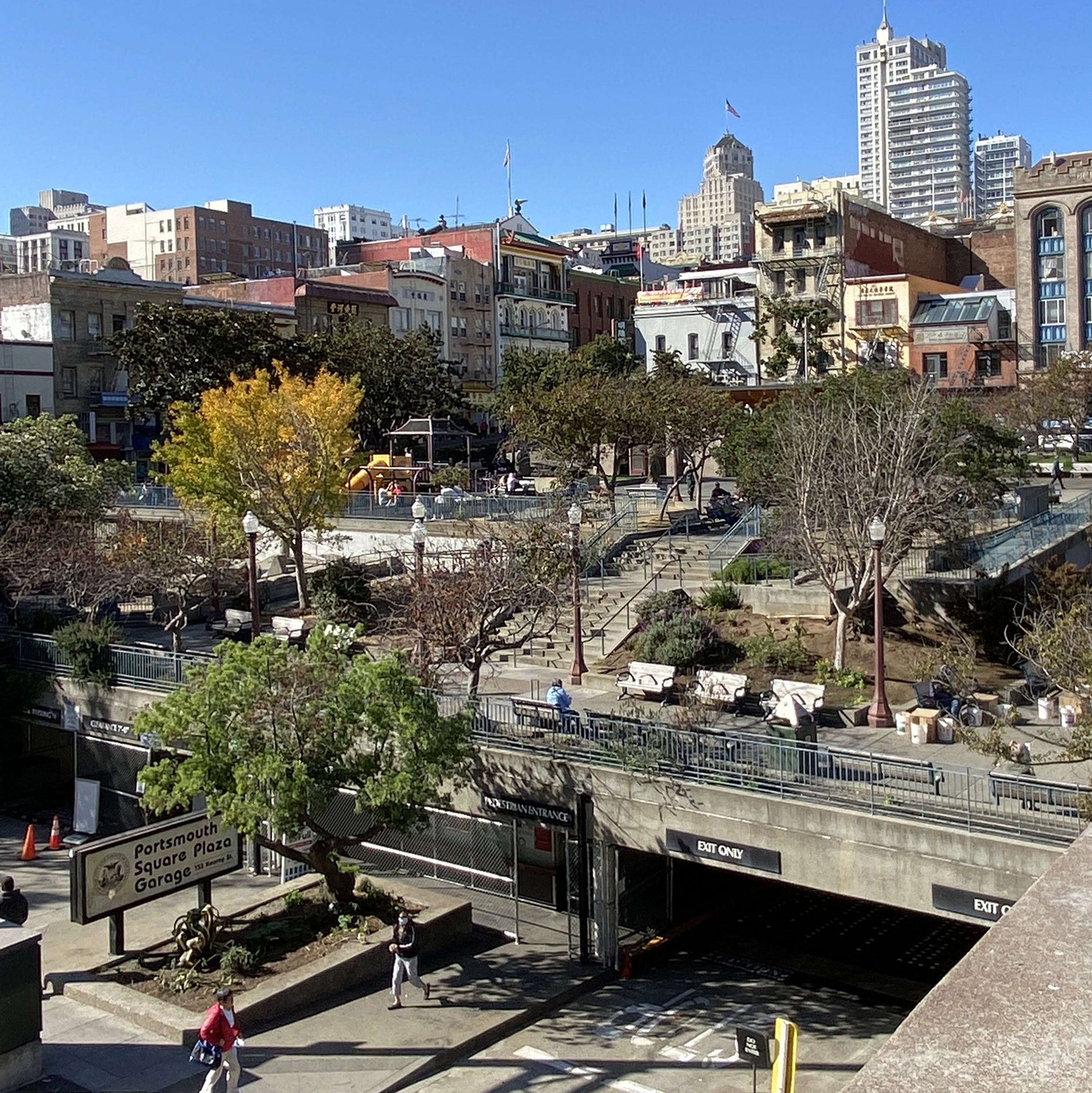After arresting Scorpio at Kezar Stadium Callahan, still bruised from his earlier beating at Mount Davidson, is summoned to the D.A.’s office and is incredulous to learn that Scorpio has been released because the, shall we say, unconventional confession tactics rendered all of the evidence inadmissible in court. The D.A. admonishes him not to get involved again.
Then … Scorpio is on the prowl again, at Portsmouth Square plaza, a historic location in the heart of Chinatown (map). At this site in 1846 during the Mexican-American war Captain John Montgomery of the U.S.S. Portsmouth planted the American flag in the Mexican community of Yerba Buena. A year later the settlement was renamed San Francisco.
and Now, he had come up from the underground garage by way of the steps seen above on the left. Today those steps are still there but the planters, lamppost and benches were added during a major redesign of the plaza in the 1990s. Scorpio was standing where the lamppost is now; the dotted yellow line shows the position of the temporary plywood wall next to him.
Then … A group of children playing in the square catches his eye. Above the temporary wall a concrete bridge that spans Kearny Street from Portsmouth Square to a hotel opposite is in its final stage of construction. The building looming above that is 728 Washington Street.
and Now, there are baluster posts spaced along the bridge walls and CitySleuth lined one of them up with 728 Washington just as in the movie shot. In the view above, the house lined up not with this one but with the next post to the left but the 1990s plaza redesign prevented CitySleuth from matching that alignment.
Here’s a photo of the bridge today viewed from the plaza. It has no access to the Hilton hotel opposite, only to the Chinese Cultural Center during limited hours; what’s more there’s no way down to Kearny Street. Consequently since its opening in 1971 it has rarely been used, other than by the pigeon community, and has earned itself the sobriquet ‘Bridge to Nowhere’. City planning approval is well under way to remove it as part of yet another major plaza redesign.
Then … The children are playing on a climbing structure; the view past it is the southeast corner of the plaza - at top right there’s a bus heading down Clay Street and the stores facing us at top left are across Kearny Street. But who’s the guy wearing sunglasses entering the crowd to the left? Callahan of course - there’s no way he’s going to leave Scorpio unwatched.
and Now, a set of steps leading to the upper level of the plaza now covers where the climbing structure used to be (a few paces to the right of the photo below); viewed from the same level here’s today’s northeast corner and the same block across Kearny.
This 1987 photo of the 2-level plaza above the Kearny Street parking garage shows it as it was in 1971 when the movie was filmed. Note the children’s climbing structure, but in the movie it was located as shown in yellow (those same park benches flanking it on two sides are the same as those in the Then image above). Click or tap the image to see the plaza today after the 1990s redesign. The old steps became a ramp and new steps were built where the play structure was, reducing the lower level to half its original width.
A group of Chinatown residents are playing Xiangqi, also called Chinese chess or elephant chess, one of the most popular board games in China. Unlike Western chess, the pieces are placed on the intersections of the squares. Behind them, Callahan stares directly at Scorpio, making sure he catches his eye.
Then … Scorpio beats a hasty retreat up to the upper level. The graffiti on the wall echoes the protest movement of the early seventies: a universal nuclear disarmament symbol, “Down With Pigs” (reaction to police brutality in ongoing Vietnam War protests), “Off the Inn” (in reference to the 1969 Stonewall Inn riots in Greenwich Village).
and Now, here’s the matching shot from the same spot but elevated, on the repositioned steps. There’s now a wrap-around ramp in place of the steps seen above. Added 1990s structures are visible on the upper level at left.
Then … A hood-mounted camera opens the movie with footage of a cab driver slowly driving north along Grant Avenue in Chinatown. In the background Sam Hui, the so-called “Elvis Presley of Hong Kong” sings a lively rock song in Cantonese to the tune of Bill Haley’s 1956 hit ‘Rock Around The Clock”. Sidewalk storefronts slide by horizontally while concurrently the top floor of the buildings, reflected, reversed and flipped 90 degrees by the steeply raked windshield, overlaps and slides by vertically. Very cool.
… and Now, this is the building seen in the Then image above. The curvilinear doorway belongs to the Buddha Lounge dive bar at 901 Grant at Washington. The brick moldings along the top of the building and the central drain pipe are also part of the Then image. Comparing Then and Now the eagle-eyed would notice that the 3rd floor balcony was not there when the movie was filmed.
Then … The music plays on while the cab pauses at a junction; in contrast to the upbeat American music the Chinese lyrics lament the inflationary food costs that make it hard for low salaried workers to survive. (Wait a minute, could that be director Wayne Wang doing a Hitchcock cameo on the right?)
… and Now, we’ve stepped back a block here, still heading north on Grant but this is the junction at Clay Street. It’s interesting to see store signs still there forty years on; example - the vertical Gifts-Arts blade above the awning. Check out too the ornate lampposts with their red lantern and intertwined dragons that line Grant Avenue; they have been there since 1938, installed in anticipation of the 1939 Panama-Pacific International Exposition.
… on location … The cab company name, Wing On, was fictional; here’s a photo of director Wang customizing an early 1970s Dodge Dart sedan by applying decals to the doors (low budget indie directors wear many hats).
… and here he’s added the taxi sign on the top to complete the transformation. For the location curious, like CitySleuth, the car is parked in front of 1851 20th Avenue in the Sunset district.
Returning to the movie, the opening song ends and the cab pulls over; the driver, Jo (Wood Moy), acknowledges a customer and beckons him in.
Then … As he drives off he muses in voiceover how all of his tourist customers ask the same question within seconds: “Hey, what’s a good place to eat in Chinatown?”. There you have it, this is what Chinatown means to the rest of the city.
… and Now, Pacific Avenue crosses ahead. There’s another surviving sign at far left: Kaye’s Footwear at 1043 Grant, but the Florsheim sign next to it is gone.
Up until 2019 the Kaye’s sign, most unusual for Chinatown, was Miami Art Nouveau in style and colors, as seen in this 2017 photo. Now painted over in mono-colored green, it is still there, minus its original charm.
Then … As he continues on, here approaching Pacific Avenue, he relates in voiceover how he and his young nephew Steve had entrusted Jo’s friend Chan Hung with $4000 in cash to arrange a sublease on a cab license so they could be their own boss. But Jo is getting worried - he hasn’t seen Chan for two days. Where is he?
… and Now, little has changed other than the store’s tenants.
Jo drops in on his nephew Steve (Marc Hayashi) and his niece Amy (Laureen Chew). Steve is a funny guy, wisecracking continuously but at the same time touching on cultural confusion and issues within the Chinese-American community seeking identity in their host country. Here he mimics, in an exaggerated accent, being asked where he’s from and what his political allegiance is:
“… Eh, what kind of ‘Chinese’ Chinese are you? PRC? Huh? Taiwan, pro Taiwan? Richmond district? Oakland hill, wa? Ho Chi Minh, yeah, yeah”.
Interestingly, this was filmed in the kitchen of Laureen Chew’s home at that time, at 416 20th Avenue in the Richmond district. The same kitchen (check out the tile patterns) was also featured, below, in Wayne Wang’s follow-on 1985 movie Dim Sum: A Little Bit Of Heart. More scenes in the same house appear later in Chan Is Missing.
Then … Callahan rushes over to the location where Scorpio revealed Ann Mary Deacon was buried. He watches as a medical team, just visible in white coats at the bottom of the image, opens an undergound vault.
… and Now, this matching view was filmed at Battery Spencer off Conzelman Road in the Marin Headlands (map), a popular tourist spot today because of its spectacular view of the Golden Gate Bridge reaching over to San Francisco. Above, Callahan was looking down from the battery to a small promontory where the victim was found, marked by the arrow below.
Here’s a wider aerial view showing where the arrowed promontory is relative to the battery complex.
Battery Spencer, armed with three M1888 12 inch guns was part of the Harbor Defense of San Francisco from 1897 until 1942 when it was deactivated. Here’s one of the guns in a c. 1913 image. Never fired in anger, only in practice. The guns were mounted on the three circular bases, still there and visible in the image above.
The young teenager is lifted out; she had been raped and murdered by Scorpio even before he came up with the lie that she had been buried alive with a limited oxygen supply. Callahan’s prediction from the start was chillingly right on (“You know she’s dead don’t you”, he had said).
It’s the morning of George’s execution; word of the murders of Susan and Henry in Paris that same day have not reached California as he is being prepared for the gas chamber. In these remarkable images filmed inside San Quentin the guards attending him were the real guards, not actors.
He is led into the gas chamber where a guard stands ready to strap him into one of the two side-by-side chairs.
The chamber door is closed tight and the guard, poised to turn on the gas, watches the clock as the final minutes tick down to the 10 am execution time.
We learn of George’s fate from a TV reporter and the telex message that brought the news of the shocking events in Paris to the Californian authorities just minutes before execution time. (Typo trivia note - the name ‘Worsmer’ should be ‘Wormser’).
Then … Speaking from within the gas chamber, viewed from outside through an open door, the reporter explains that the telephone next to the chamber with a direct connection to the Governor’s office rang just before the deadline with a reprieve order. George’s life had been spared and he was released.
… and Now, here’s that same door in a March 2019 photo, now closed and referencing Executive Order N-09-19 which reprieved all prisoners on death row at that time from execution and banned further capital punishment during the term of the current Governor. This after the State had spent $5 billion on a death penalty system that had executed only 13 people since 1978.
Then … The movie ends with an overhead shot of San Quentin Prison. The panorama below captures the entrance area of the prison at lower right and on the left looks east across the Richmond-San Rafael bridge towards Contra Costa County in the distance.
… and Now, here’s a recent aerial view of the prison and of the bridge, the northernmost east-west road crossing of San Francisco Bay (map). Both are still there and operational.



